The Zotac GTX 1070 AMP! Extreme Review
Share:
Author: SKYMTL
Date: August 17, 2016
Product Name: GTX 1070 AMP! Extreme
Part Number: ZT-P10700B-10P
Warranty: 3 Years
The other day I had the luxury of time to look back at our graphics card reviews for the last few months and a certain trend emerged. With the exception of launch-day coverage of NVIDIA’s GTX 1060 and AMD’s Polaris twins –the RX 480 and RX 470- our pages have been pretty much focused on premium top-level products. There’s been the awesomely expensive TITAN X and GTX 1080’s like MSI Gaming X, EVGA’s Superclocked and Gigabyte’s G1 Gaming. While it’s certainly nice to ogle at each card’s amazing performance, GTX 1070’s have been very much ignored and, if my inbox is any indicator, our readers have noticed. Well, the lack of GTX 1070 coverage ends today with the Zotac GTX 1070 AMP! Extreme, and what a card it is!
Zotac’s AMP! Extreme may seem like an odd starting point for our deluge of GTX 1070 reviews but I figure we may as well start at the top of the heap and work our way down. You see, historically the Extremes lie well above other cards in Zotac’s lineup and this time is no different. These are big, brutish cards that do away with the niceties of sleek heatsinks or conservative clock speeds and throw caution into the wind by simply being marketed as the fastest, coolest running GPUs in their respective ranges.
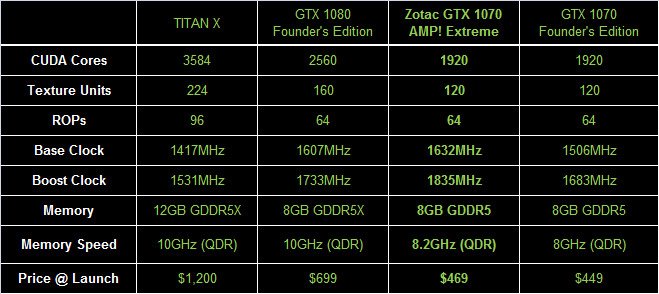
With Zotac talking about this thing like it was the Second Coming, I had some understandably high expectations and on paper at least the Extreme is epic for a GTX 1070. Not only is its Base Clock within spitting distance of NVIDIA’s Founders Edition average Boost speed, but it should hit well north of 1800MHz on a regular basis. This results in one of the fastest air-cooled GTX 1070’s available right now and that memory overclock of 200MHz could push performance even higher. Actually, Zotac is just about the only board partner that has increased GDDR5 speeds frequencies on their premium offering. Kudos to them for taking the path less travelled.
Alongside those impressive frequency numbers comes a hefty price tag, though one that is still substantially lower than the least expensive GTX 1080. At $469 (or a staggering $615 here in Canada) the GTX 1070 AMP! Extreme is a good $20 more expensive than NVIDIA’s Founders Edition but still quite a ways away from the likes of MSI’s Sea Hawk, EVGA’s Hybrid and MSI’s Gaming Z. Despite its price, the AMP! Extreme hasn’t been saved from NVIDIA’s chronic GTX 1070 shortages but the situation does seem to be improving since this card is back in stock at several retailers as I write this. Along with the slightly lower-tier AMP! Edition, it also happens to be one of the more popular GTX 1070’s on etailers’ shelves.

I have a special place in my heart for Zotac’s Extreme Editions since they are unabashedly oversized and make no qualms about putting cooling performance above compactness. That extremely efficient GTX 1070 core which could end up being carried forward en masse to the notebook sector? Forgetaboutit! This is all about excess regardless of what’s beating at its heart.
This one also looks pretty damn good with its simple black, grey and white exterior which is rather stealthy regardless of the epic 12 ¾” length. Another thing to take note of is the heft and size of this particular GPU could add to shipping costs versus the competition. It really is that big.

The GTX 1070 AMP! Extreme is graced with the presence of Zotac’s updated Icestorm cooler which is designed to offer the most thermal dissipation mass on the market. While this approach may look slightly ridiculous and ham-fisted compared to the designs backing current ASUS, EVGA and MSI cards, there’s a method behind Zotac’s madness: more mass combined with an efficient cooler design could lead to fans operating at lower RPMs. Could this be the quietest high end card we have reviewed to date? Maybe…
About those fans, they utilize Zotac’s proprietary EKO design which adds secondary fins to reduce any dead spots caused by the central hub while also improving airflow by 30% over more conventional units and reducing noise. They will also completely shut off in idle and low load situations, provided the temperatures remain under the 70°C mark.

Below the cooler’s shroud lies a vast heatsink with copper heatpipes that makes direct contact with everything from the core to PWM components. Its fins have been engineered to reduce static pressure requirements from the fans while optimizing heat dissipation as well.
In addition to all of this, Zotac is using a completely custom PCB with heavily upgraded components. As we’ve seen in the past, if a decision has been made to stick to NVIDIA’s preset Power and Voltage limits, all of these additions may be for nothing since they won’t have any positive impact upon overclocking.

As you have already guessed, there are two pretty significant tradeoffs with Zotac’s gargantuan heatsink: its height and length. Not only does the Icestorm heatsink eat up about an inch of extra length as it overhangs the AMP! Extreme’s PCB but it also contributes to a triple-slot height. Make special note of this when selecting a case or, if SLI is in your future, a suitably compatible motherboard.

Flip the card over and the clean, almost timeless design of the front side gets lost in a cacophony of colors, catch-phrases, logos and cut-outs. Personally, I absolutely love the gunmetal grey with yellow highlights look but the illuminated “Push the Limit” sign is a bit much in my books. Who knows, maybe some folks will be sold on this look but I’m not.

The golden rectangular Power Boost outcropping is actually a so-called “supercapacitor” and feels like a blast from the past since ASUS used to used something like this on their higher end graphics cards a few generations ago. Back then it an NEC / Tokin Proadlizer but Zotac has removed or capped any sourcing information. Nonethless, this extra solid state capacitor is meant to further regulate voltage fluctuations and reduce ripple which should, in theory at least, extend the life of the AMP!’s components.

Pretty much everything about this particular GTX 1070 is extreme, right down to the power input which is handled by a pair of 8-pin connectors. What kind of Pascal card (other than the TITAN X that is) could possibly need over 300W of current? Zotac obviously doesn’t want mere mortals asking these pointless questions, so who cares…

Regardless of the countless upgrades made to this card, the I/O plate is pretty much bone stock. There’s a trio of DisplayPort 1.4 outputs, a single HDMI 2.0 and one dual link DVI.
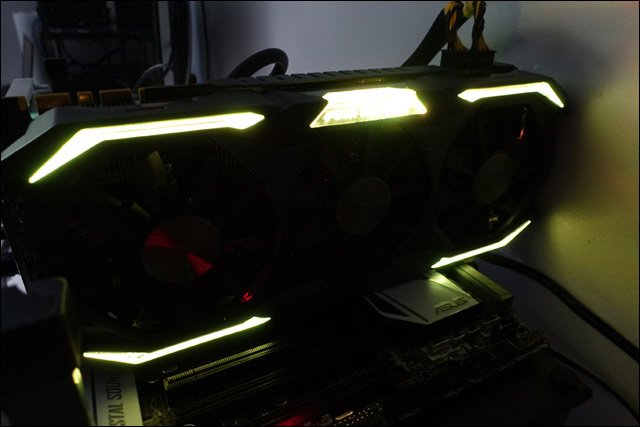
Zotac’s cooler has a number of tastefully integrated LEDs around the perimeter which aren’t fully RGB compliant due to software limitations but their color pallet should cover most people’s needs.

Around back there’s the oddball “Push the Limits” LED which can’t be turned off individually but it nonetheless provides a bit of ambience.

Zotac’s Firestorm software has gone through several evolutions over the years and this version is not only the most straightforward but it also happens to be extremely functional for both newcomers and veterans alike. The first page provides overclocking functionality, fan speed control, monitoring and a BIOS update function which could come in handy if enthusiasts post custom BIOS files. The second page is mostly the same but it includes some very basic LED functionality (only 7 different colors alongside some behavior modifiers) and not much else.
Test System & Setup
Processor: Intel i7 5960X @ 4.3GHz
Memory: G.Skill Trident X 32GB @ 3000MHz 15-16-16-35-1T
Motherboard: ASUS X99 Deluxe
Cooling: NH-U14S
SSD: 2x Kingston HyperX 3K 480GB
Power Supply: Corsair AX1200
Monitor: Dell U2713HM (1440P) / Acer XB280HK (4K)
OS: Windows 10 Pro
Drivers:
AMD Radeon Software 16.5.2
NVIDIA 368.14 WHQL
*Notes:
– All games tested have been patched to their latest version
– The OS has had all the latest hotfixes and updates installed
– All scores you see are the averages after 3 benchmark runs
All IQ settings were adjusted in-game and all GPU control panels were set to use application settings
The Methodology of Frame Testing, Distilled
How do you benchmark an onscreen experience? That question has plagued graphics card evaluations for years. While framerates give an accurate measurement of raw performance , there’s a lot more going on behind the scenes which a basic frames per second measurement by FRAPS or a similar application just can’t show. A good example of this is how “stuttering” can occur but may not be picked up by typical min/max/average benchmarking.
Before we go on, a basic explanation of FRAPS’ frames per second benchmarking method is important. FRAPS determines FPS rates by simply logging and averaging out how many frames are rendered within a single second. The average framerate measurement is taken by dividing the total number of rendered frames by the length of the benchmark being run. For example, if a 60 second sequence is used and the GPU renders 4,000 frames over the course of that time, the average result will be 66.67FPS. The minimum and maximum values meanwhile are simply two data points representing single second intervals which took the longest and shortest amount of time to render. Combining these values together gives an accurate, albeit very narrow snapshot of graphics subsystem performance and it isn’t quite representative of what you’ll actually see on the screen.
FCAT on the other hand has the capability to log onscreen average framerates for each second of a benchmark sequence, resulting in the “FPS over time” graphs. It does this by simply logging the reported framerate result once per second. However, in real world applications, a single second is actually a long period of time, meaning the human eye can pick up on onscreen deviations much quicker than this method can actually report them. So what can actually happens within each second of time? A whole lot since each second of gameplay time can consist of dozens or even hundreds (if your graphics card is fast enough) of frames. This brings us to frame time testing and where the Frame Time Analysis Tool gets factored into this equation.
Frame times simply represent the length of time (in milliseconds) it takes the graphics card to render and display each individual frame. Measuring the interval between frames allows for a detailed millisecond by millisecond evaluation of frame times rather than averaging things out over a full second. The larger the amount of time, the longer each frame takes to render. This detailed reporting just isn’t possible with standard benchmark methods.
We are now using FCAT for ALL benchmark results in DX11.
DX12 Benchmarking
For DX12 many of these same metrics can be utilized through a simple program called PresentMon. Not only does this program have the capability to log frame times at various stages throughout the rendering pipeline but it also grants a slightly more detailed look into how certain API and external elements can slow down rendering times.
Since PresentMon throws out massive amounts of frametime data, we have decided to distill the information down into slightly more easy-to-understand graphs. Within them, we have taken several thousand datapoints (in some cases tens of thousands), converted the frametime milliseconds over the course of each benchmark run to frames per second and then graphed the results. This gives us a straightforward framerate over time graph. Meanwhile the typical bar graph averages out every data point as its presented.
One thing to note is that our DX12 PresentMon results cannot and should not be directly compared to the FCAT-based DX11 results. They should be taken as a separate entity and discussed as such.
Ashes of the Singularity
Ashes of the Singularity is a real time strategy game on a grand scale, very much in the vein of Supreme Commander. While this game is most known for is Asynchronous workloads through the DX12 API, it also happens to be pretty fun to play. While Ashes has a built-in performance counter alongside its built-in benchmark utility, we found it to be highly unreliable and often posts a substantial run-to-run variation. With that in mind we still used the onboard benchmark since it eliminates the randomness that arises when actually playing the game but utilized the PresentMon utility to log performance


Fallout 4
The latest iteration of the Fallout franchise is a great looking game with all of its detailed turned to their highest levels but it also requires a huge amount of graphics horsepower to properly run. For this benchmark we complete a run-through from within a town, shoot up a vehicle to test performance when in combat and finally end atop a hill overlooking the town. Note that VSync has been forced off within the game’s .ini file.


Far Cry 4
This game Ubisoft’s Far Cry series takes up where the others left off by boasting some of the most impressive visuals we’ve seen. In order to emulate typical gameplay we run through the game’s main village, head out through an open area and then transition to the lower areas via a zipline.


Grand Theft Auto V
In GTA V we take a simple approach to benchmarking: the in-game benchmark tool is used. However, due to the randomness within the game itself, only the last sequence is actually used since it best represents gameplay mechanics.
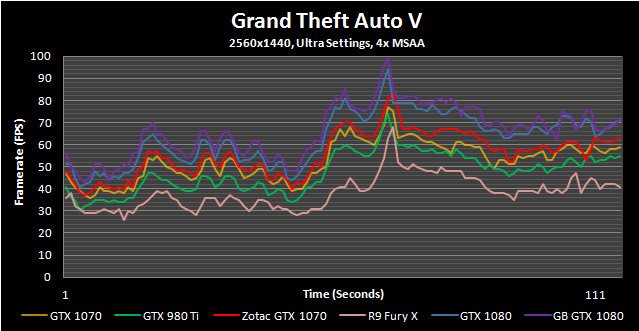

Hitman (2016)
The Hitman franchise has been around in one way or another for the better part of a decade and this latest version is arguably the best looking. Adjustable to both DX11 and DX12 APIs, it has a ton of graphics options, some of which are only available under DX12.
For our benchmark we avoid using the in-game benchmark since it doesn’t represent actual in-game situations. Instead the second mission in Paris is used. Here we walk into the mansion, mingle with the crowds and eventually end up within the fashion show area.


Rise of the Tomb Raider
Another year and another Tomb Raider game. This time Lara’s journey continues through various beautifully rendered locales. Like Hitman, Rise of the Tomb Raider has both DX11 and DX12 API paths and incorporates a completely pointless built-in benchmark sequence.
The benchmark run we use is within the Soviet Installation level where we start in at about the midpoint, run through a warehouse with some burning its and then finish inside a fenced-in area during a snowstorm.[/I]


Star Wars Battlefront
Star Wars Battlefront may not be one of the most demanding games on the market but it is quite widely played. It also looks pretty good due to it being based upon Dice’s Frostbite engine and has been highly optimized.
The benchmark run in this game is pretty straightforward: we use the AT-ST single player level since it has predetermined events and it loads up on many in-game special effects.


The Division
The Division has some of the best visuals of any game available right now even though its graphics were supposedly downgraded right before launch. Unfortunately, actually benchmarking it is a challenge in and of itself. Due to the game’s dynamic day / night and weather cycle it is almost impossible to achieve a repeatable run within the game itself. With that taken into account we decided to use the in-game benchmark tool.


Witcher 3
Other than being one of 2015’s most highly regarded games, The Witcher 3 also happens to be one of the most visually stunning as well. This benchmark sequence has us riding through a town and running through the woods; two elements that will likely take up the vast majority of in-game time.


Ashes of the Singularity


Fallout 4


Far Cry 4
This game Ubisoft’s Far Cry series takes up where the others left off by boasting some of the most impressive visuals we’ve seen. In order to emulate typical gameplay we run through the game’s main village, head out through an open area and then transition to the lower areas via a zipline.


Grand Theft Auto V
In GTA V we take a simple approach to benchmarking: the in-game benchmark tool is used. However, due to the randomness within the game itself, only the last sequence is actually used since it best represents gameplay mechanics.


Hitman (2016)


Rise of the Tomb Raider


Star Wars Battlefront


The Division


Witcher 3
Other than being one of 2015’s most highly regarded games, The Witcher 3 also happens to be one of the most visually stunning as well. This benchmark sequence has us riding through a town and running through the woods; two elements that will likely take up the vast majority of in-game time.


Ashes of the Singularity


Hitman (2016)


Quantum Break
Years from now people likely won’t be asking if a GPU can play Crysis, they’ll be asking if it was up to the task of playing Quantum Break with all settings maxed out. This game was launched as a horribly broken mess but it has evolved into an amazing looking tour de force for graphics fidelity. It also happens to be a performance killer.
Though finding an area within Quantum Break to benchmark is challenging, we finally settled upon the first level where you exit the elevator and find dozens of SWAT team members frozen in time. It combines indoor and outdoor scenery along with some of the best lighting effects we’ve ever seen.


Rise of the Tomb Raider


Ashes of the Singularity


Hitman (2016)


Quantum Break

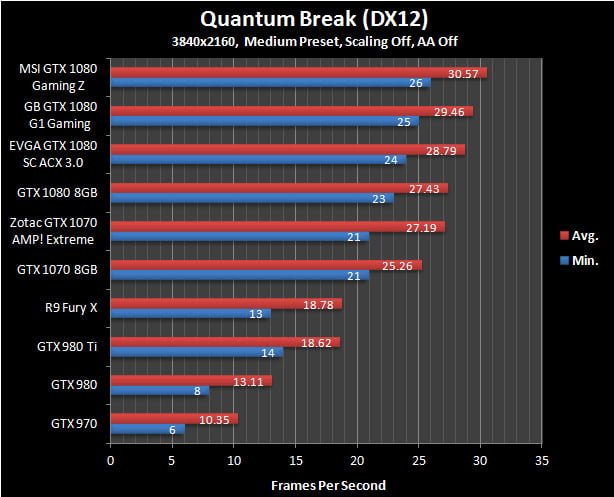
Rise of the Tomb Raider
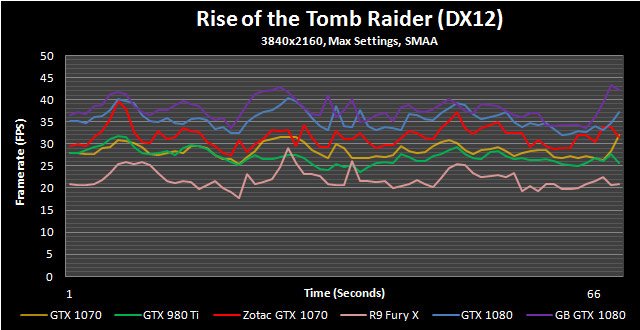

Analyzing Temperatures & Frequencies Over Time
Modern graphics card designs make use of several advanced hardware and software facing algorithms in an effort to hit an optimal balance between performance, acoustics, voltage, power and heat output. Traditionally this leads to maximized clock speeds within a given set of parameters. Conversely, if one of those last two metrics (those being heat and power consumption) steps into the equation in a negative manner it is quite likely that voltages and resulting core clocks will be reduced to insure the GPU remains within design specifications. We’ve seen this happen quite aggressively on some AMD cards while NVIDIA’s reference cards also tend to fluctuate their frequencies. To be clear, this is a feature by design rather than a problem in most situations.
In many cases clock speeds won’t be touched until the card in question reaches a preset temperature, whereupon the software and onboard hardware will work in tandem to carefully regulate other areas such as fan speeds and voltages to insure maximum frequency output without an overly loud fan. Since this algorithm typically doesn’t kick into full force in the first few minutes of gaming, the “true” performance of many graphics cards won’t be realized through a typical 1-3 minute benchmarking run. Hence why we use a 10-minute warm up period before all of our benchmarks.
For now, let’s see how these new algorithms are used when the card is running at default speeds.

Considering this card’s massive heatsink these temperatures should’t come as any surprise. They’re extremely low, constant and well controlled regardless of the overclocked core and memory.

The fan speeds over time chart needs a bit of explanation. What you are seeing above is an RPM readout from the center of Zotac’s three fans which seems to be on a completely separate PWM circuit from the other two. Due to the heatsink containing a ton of extra thermal capacity, the fan’s hardly have to work but that also causes the center fan to enter a quasi-sleep mode during short spurts.
On one hand this is a good thing since it points towards potentially lower acoustics. However, that isn’t the case. From my experience the quick upwards / downwards rotational speed shifts become noticeable since the fan isn’t running at a continuous speed regardless of the low “maximum” of 1350RPMs. Luckily, this can be easily overcome by setting a custom fan speed profile to about 20%.

The AMP! Extreme’s clock speeds are quite the revelation when compared against the Founders Edition. Not only are they constant but the card was able to hit 1974MHz without any manual overclocking which is a bit higher than Zotac’s own stated Boost clock. Not bad at all!

It goes without saying this card is quite a bit faster than the Founder’s Edition.
Thermal Imaging
While the thermal images didn’t pick up any anomalies (not like I expected then to) it should be mentioned that Zotac’s cooler is designed in such a way that ALL of the heat it dissipates remains within your case. Now the GTX 1070 isn’t a hot running card to begin with and the AMP! Extreme will only fit into the largest of enclosures but this is still something that needs to be taken into account.
Acoustical Testing
What you see below are the baseline idle dB(A) results attained for a relatively quiet open-case system (specs are in the Methodology section) sans GPU along with the attained results for each individual card in idle and load scenarios. The meter we use has been calibrated and is placed at seated ear-level exactly 12” away from the GPU’s fan. For the load scenarios, Hitman Absolution is used in order to generate a constant load on the GPU(s) over the course of 15 minutes.

Dead quiet. What more can really be said? The AMP! is able to achieve some of the lowest noise results I’ve ever seen. While it may be the absolute quietest, it’s the only one to not make any clock speed sacrifices to achieve near-silent performance. That in itself is simply incredible.
System Power Consumption
For this test we hooked up our power supply to a UPM power meter that will log the power consumption of the whole system twice every second. In order to stress the GPU as much as possible we used 15 minutes of Unigine Valley running on a loop while letting the card sit at a stable Windows desktop for 15 minutes to determine the peak idle power consumption.

Despite the fact Zotac’s AMP! Extreme runs cool, this is still an overclocked card and as a result it does gobble up a bit more power than the reference version.
Overclocking Results; Moah Powah!!
In previous reviews, I’ve mentioned that I have a bit of a problem with the way NVIDIA’s board partners go about user-initiated overclocking. By and large, despite offering all sorts of “upgrades” that are supposed to help achieve ever higher clock speeds they all stick to the exact same Power and Voltage limits. This causes a real lack of differentiation since even though a ton of costly technology is thrown into these custom boards, it’s all for nothing if they all overclock to about the same level.
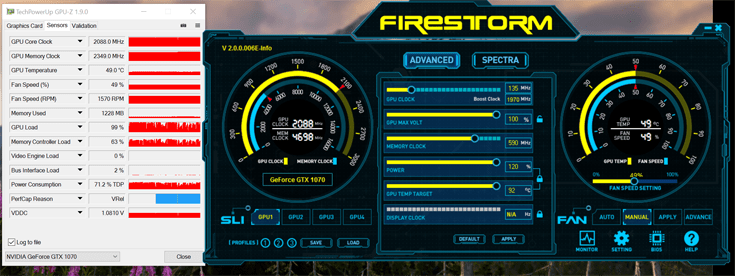
Zotac bucks this trend to a certain extent. Instead of offering the same pathetic 12% of additional overhead that’s featured on the Founders Edition and many other competitors, the AMP! Extreme’s slider can hit 120%. Not much but it does have a small effect. Unfortunately, voltage is still pegged at a nebulous “100%” which ends of being something of a bottleneck.
The final clock speeds were 2088MHz on the core and memory running at an impressive 9396MHz. While that core speed isn’t all that much higher than our Founders Edition’s 2025MHz there’s still a small bit of open air between the two. In addition, these frequencies almost allow this card to catch up with the much more expensive GTX 1080 in some situations. Zotac doesn’t stop there either; I’m sure there will be BIOS hackers who crack things open to run higher voltages and with the Firestorm software, updating the card with a new firmware is extremely straightforward.


Conclusion; Big GPU, Bigger Expectations
There are some who say good things come in small packages but I’m not one of those. I don’t know about you but every Christmas I’m the one staring in envy at the biggest present under tree in the secret hope it has my name on it. The Zotac GTX 1070 AMP! Extreme is for folks like me. This thing is brash, unapologetically huge and about as subtle as a slap to the face with a wet fish. I absolutely love it.
If you are looking for a compact graphics card that will fit into an SFF chassis, you may as well stop reading now since, at almost 13” in length this GTX 1070 may actually have a tough time fitting into some ATX cases. While most people will know what they’re getting into here, this is nonetheless something that should be mentioned.
The AMP! Extreme’s physical size may be its only real downfall but also one of its greatest assets; think of it as the John Holmes of graphics cards….and don’t Google that name at work. Unlike some of their competitors, Zotac has been able to leverage this GTX 1070’s length and girth to good effect. The heatsink provides some of the lowest temperatures I’ve seen from a Pascal-based GPU and that’s been coupled with such low noise output I had to check a few times to assure myself the fans were actually running.
The only small hiccup in the whole setup is the center fan which pulsates on an off, creating an ever so slight noise that’s a bit distracting since it isn’t continual. Luckily that can be rectified with a custom fan speed curve.
On the performance front Zotac’s AMP! Extreme delivers too with an average of 10% faster in-game framerates than the Founders Edition. There’s very little chance anyone would notice any difference in a blind testing but those additional frames do take this card a bit closer to the GTX 1080, a GPU that commands a $240 premium.
Overclocking was an area I had some extremely high expectations and the AMP! Extreme didn’t let me down for the most part. The additional 8% of Power Limit overhead is certainly a welcome addition and Zotac needs to be commended to bucking a trend that curtails overclocking at NVIDIA-enforced barriers. However, the Voltage Limit still stepped in like an overzealous traffic cop when trying to move beyond 2090MHz but at those speeds the GTX 1070 AMP! Extreme can absolutely fly.
There will likely be some may debate about whether or not Zotac’s flagship GTX 1070 is really worth so much more than other custom designs. I’m a firm believer that in this situation, you get what you pay for. The AMP! Extreme is everything you could want in a graphics card: it is fast, quiet, cool running and features a good amount of overclocking headroom. If your case will fit Zotac’s monster and your pocketbook can handle it, then go for it!




